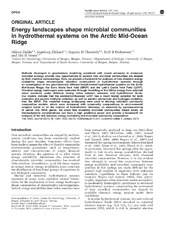| dc.contributor.author | Dahle, Håkon | |
| dc.contributor.author | Økland, Ingeborg Elisabet | |
| dc.contributor.author | Thorseth, Ingunn Hindenes | |
| dc.contributor.author | Pedersen, Rolf B. | |
| dc.contributor.author | Steen, Ida Helene | |
| dc.date.accessioned | 2016-01-15T12:52:12Z | |
| dc.date.available | 2016-01-15T12:52:12Z | |
| dc.date.issued | 2015-01-09 | |
| dc.Published | The ISME Journal 2015, 9(7):1593-1606 | eng |
| dc.identifier.issn | 1751-7370 | en_US |
| dc.identifier.uri | https://hdl.handle.net/1956/10968 | |
| dc.description.abstract | Methods developed in geochemical modelling combined with recent advances in molecular microbial ecology provide new opportunities to explore how microbial communities are shaped by their chemical surroundings. Here, we present a framework for analyses of how chemical energy availability shape chemotrophic microbial communities in hydrothermal systems through an investigation of two geochemically different basalt-hosted hydrothermal systems on the Arctic Mid-Ocean Ridge: the Soria Moria Vent field (SMVF) and the Loki’s Castle Vent Field (LCVF). Chemical energy landscapes were evaluated through modelling of the Gibbs energy from selected redox reactions under different mixing ratios between seawater and hydrothermal fluids. Our models indicate that the sediment-influenced LCVF has a much higher potential for both anaerobic and aerobic methane oxidation, as well as aerobic ammonium and hydrogen oxidation, than the SMVF. The modelled energy landscapes were used to develop microbial community composition models, which were compared with community compositions in environmental samples inside or on the exterior of hydrothermal chimneys, as assessed by pyrosequencing of partial 16S rRNA genes. We show that modelled microbial communities based solely on thermodynamic considerations can have a high predictive power and provide a framework for analyses of the link between energy availability and microbial community composition. | en_US |
| dc.language.iso | eng | eng |
| dc.publisher | Nature Publishing Group (NPG) | en_US |
| dc.rights | Attribution CC BY-NC-ND 3.0 | eng |
| dc.rights.uri | http://creativecommons.org/licenses/by-nc-nd/3.0 | eng |
| dc.subject | Arctic mid-ocean ridge | eng |
| dc.subject | hydrothermal systems | eng |
| dc.title | Energy landscapes shape microbial communities in hydrothermal systems on the Arctic Mid-Ocean Ridge | en_US |
| dc.type | Peer reviewed | |
| dc.type | Journal article | |
| dc.date.updated | 2015-12-30T16:57:53Z | |
| dc.description.version | publishedVersion | en_US |
| dc.rights.holder | Copyright 2015, Rights Managed by Nature Publishing Group | en_US |
| dc.identifier.doi | https://doi.org/10.1038/ismej.2014.247 | |
| dc.identifier.cristin | 1194696 | |
| dc.relation.project | Norges forskningsråd: 179560 | |
| dc.subject.nsi | VDP::Matematikk og naturvitenskap: 400::Zoologiske og botaniske fag: 480::Økologi: 488 | |
| dc.subject.nsi | VDP::Mathematics and natural scienses: 400::Zoology and botany: 480::Ecology: 488 | |
| dc.subject.nsi | VDP::Matematikk og Naturvitenskap: 400 | en_US |

